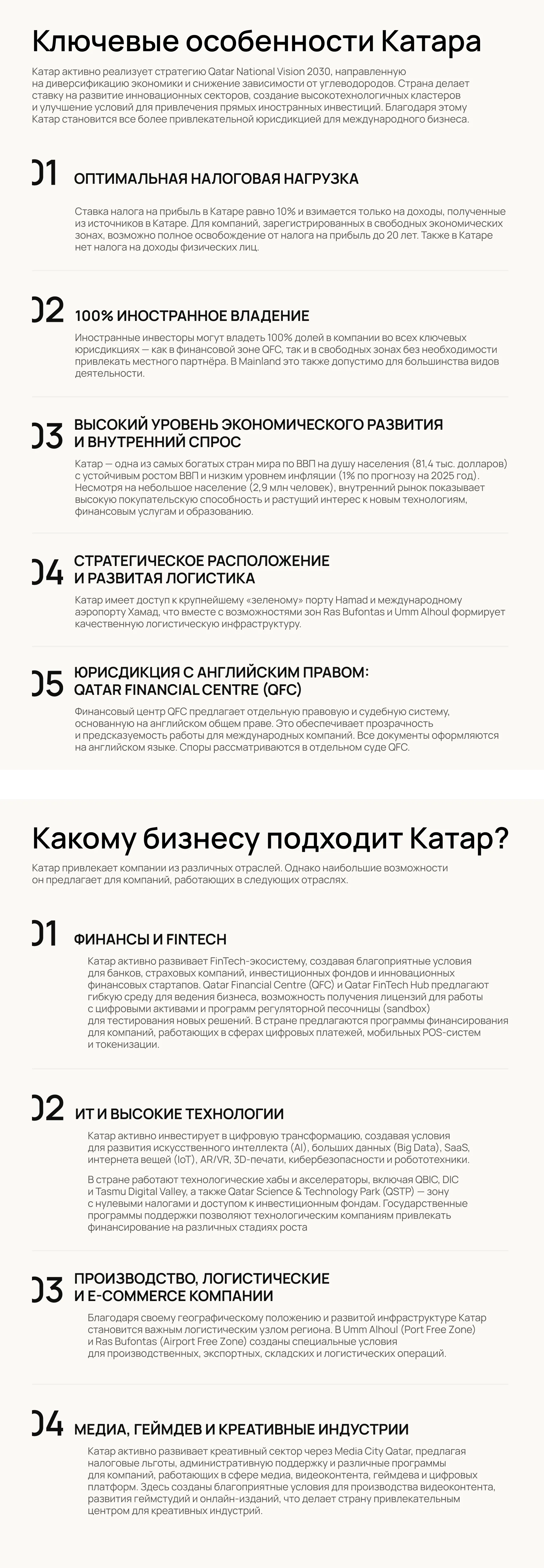Taxes and accounting
Main taxes and fees in Oman
Oman, known for its political stability and strategic location, offers one of the most attractive tax systems in the Middle East.
Contact us

Overview
Low rates, transparent regulations, and the absence of key taxes for individuals make the country ideal for business and investment. Let’s break down the tax system in Oman in 2025.
VAT
The introduction of VAT in 2021 became part of the Vision 2040 strategy aimed at developing Oman’s non-oil sectors.
Who pays?
- Companies registered in Oman
- Non-resident companies whose supplies are subject to VAT in Oman
Tax base
The total amount charged for the supply subject to VAT, including expenses and fees charged to the recipient in the course of supply (except for certain subsidies, grants, etc., specified in regulations).
Tax period
Quarterly
Rates
Depends on the taxable operation:
- 5% – standard rate applied to most goods and services, including e-commerce
- 0% – export operations; supplies of certain food products; supplies of oil, gas, petroleum products, and natural gas; international transport; supplies of certain medical products or equipment; supplies of investment metals (gold, silver, platinum)
Exempt from VAT
- Sale of certain types of land and real estate
- Passenger transport services
- Medical services and goods
- Educational services
VAT registration thresholds
- Mandatory registration: taxable turnover reached 38,500 OMR (~100,000 USD)
- Voluntary registration: taxable turnover reached 19,250 OMR (~50,000 USD)
- Non-residents must register once they perform their first taxable operation in Oman.
“The introduction of VAT increases the administrative burden on companies, especially small and medium businesses. However, large companies can reclaim VAT paid to suppliers, reducing the overall tax burden." Ivan Egorov Associate
VAT GCC Agreement: How Oman Integrates the Regional Tax into Its Economy
In 2016, the GCC countries (Gulf Cooperation Council) signed a Unified VAT Agreement.
The agreement aims to diversify economies: GCC countries, where oil and gas account for up to 80% of the budget, seek to create alternative sources of revenue. VAT has become a tool for financing infrastructure, healthcare, and education.
Each GCC country retained the right to adapt the rules to its needs. For example:
- Saudi Arabia and the UAE introduced VAT in 2018
- Bahrain in 2019
- Qatar and Oman joined later (2023)
Corporate Income Tax (CIT)
Unlike many countries where the corporate tax burden is universal, Oman applies a differentiated approach depending on the industry, company residency status, and business location.
Who pays
- Companies with foreign participation registered in Oman
- Non-resident companies receiving income from sources in Oman
Not applicable to local companies owned by Omani citizens or wholly Omani legal entities.
Tax base
Profit (operating income, dividends, loan interest, royalties, etc.) after deducting expenses.
Tax period
Calendar year
Tax rate
Depends on the industry:
- 15% – general rate
- 55% – for oil and gas companies
From 2025, Oman applies a Global Minimum Corporate Tax of 15% for multinational corporations (Domestic Minimum Top-up Tax, DMTT) with revenues exceeding EUR 750 million for two of the last four years.
“The global minimum tax is a new international standard developed by the OECD under the BEPS 2.0 project (Base Erosion and Profit Shifting). Its goal is to set a minimum corporate tax rate for large multinational companies to prevent the use of low-tax jurisdictions.” Alexandra Kurdyumova Co-founder, Senior Partner
CIT Incentives for Small and Medium Businesses
Oman offers tax incentives for small and medium businesses (in the form of partnerships or LLCs), reducing the CIT rate to 3% if the following conditions are met:
- Authorized capital is less than 50,000 OMR (~130,000 USD)
- Annual revenue does not exceed 100,000 OMR (~260,000 USD)
- Average number of employees per year does not exceed 15
- The company does not operate in: air or maritime transport, natural resource extraction, banking, insurance, or other financial services, utilities
Withholding Tax (WHT)
Withholding tax applies to payments to non-residents, but its scope in Oman is limited.
When payable
- Royalties for intellectual property use
- Payments for technical, consulting, or management services to non-residents
Rate
10%
Exemptions from WHT
- Dividends and loan interest
- Payments to companies from countries with double tax treaties (e.g., India, China, Turkey)
Note: Oman has no DTA with the USA, so dividends/royalties/loan interest from the US to Oman are subject to 30% withholding tax in the US.
Examples:
- Google Ads payments usually come from the US → 30% WHT applies
- Google Play payments may come from the US or Ireland: from the US → 30% WHT; from Ireland → No WHT; steam valve payments → 30% WHT on all US-source income
Personal Income Tax (PIT)
Oman does not have personal income tax. Salaries, dividends, bank interest, and other income types of individuals are not taxed. However, companies must pay social security contributions for Omani employees.
There is ongoing work to introduce PIT from 2026, with a proposed rate between 5–9%.
Planned thresholds:
- For foreign nationals → annual income above 30,000 OMR (~78,000 USD) or 100,000 USD of Oman-source income
- For Omani citizens → annual income above 1,000,000 USD
A complete roadmap for launching and running a business in Oman — in our guide 'How to Do Business in Oman?'
In the guide, you will find not only basic information but also expert recommendations based on real cases and deep jurisdictional expertise:
- Which types of businesses are best suited for Oman
- Key steps to launching a business in Oman
- Detailed descriptions of the processes for starting a business in Oman’s free zones and Mainland
Related services
Ready to discuss your project?
Leave a request, and we will contact you to clarify details:
- We will select the right activity type and jurisdiction
- Outline all stages of company setup
- Provide clear timelines and project budget
















